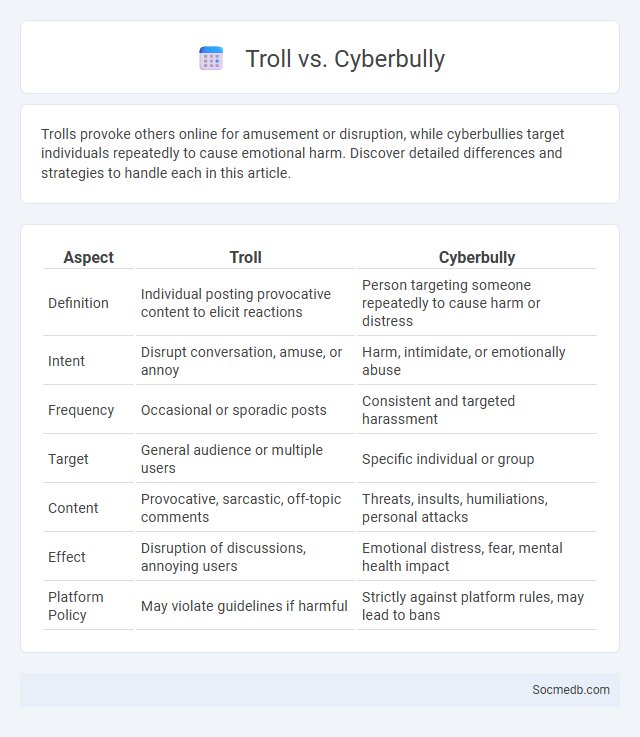
Photo illustration: Troll vs Cyberbully
Trolls provoke others online for amusement or disruption, while cyberbullies target individuals repeatedly to cause emotional harm. Discover detailed differences and strategies to handle each in this article.
Table of Comparison
| Aspect | Troll | Cyberbully |
|---|---|---|
| Definition | Individual posting provocative content to elicit reactions | Person targeting someone repeatedly to cause harm or distress |
| Intent | Disrupt conversation, amuse, or annoy | Harm, intimidate, or emotionally abuse |
| Frequency | Occasional or sporadic posts | Consistent and targeted harassment |
| Target | General audience or multiple users | Specific individual or group |
| Content | Provocative, sarcastic, off-topic comments | Threats, insults, humiliations, personal attacks |
| Effect | Disruption of discussions, annoying users | Emotional distress, fear, mental health impact |
| Platform Policy | May violate guidelines if harmful | Strictly against platform rules, may lead to bans |
Understanding the Differences: Troll vs Cyberbully
Understanding the differences between a troll and a cyberbully is crucial for managing online interactions effectively. A troll provokes and disrupts conversations for amusement or attention, often without personal targeting, whereas a cyberbully engages in repeated, targeted harassment intending to harm or intimidate you emotionally. Recognizing these behaviors helps you respond appropriately, safeguarding your mental well-being on social media.
Defining Trolls: Motivation and Tactics
Trolls on social media are individuals or groups who deliberately provoke, harass, or disrupt online communities using inflammatory posts, false information, and personal attacks. Their motivation often stems from seeking attention, causing chaos, or expressing dissent, leveraging anonymity and psychological manipulation to evade accountability. Common tactics include spreading misinformation, baiting users into emotional responses, and exploiting platform algorithms to maximize visibility and impact.
Cyberbullying Unveiled: Key Characteristics
Cyberbullying involves repeated aggressive behavior through digital platforms, targeting victims with harmful messages, threats, or harassment to cause emotional distress. Key characteristics include anonymity of perpetrators, the viral nature of harmful content, and the pervasive impact on mental health, often leading to anxiety, depression, and social withdrawal. Platforms like Instagram, TikTok, and Snapchat report high incidences, prompting the implementation of stricter moderation tools and reporting mechanisms to combat this growing issue.
Overlapping Behaviors: Where Trolls and Cyberbullies Meet
Trolls and cyberbullies often exhibit overlapping behaviors such as spreading harmful content, targeting individuals with personal attacks, and creating hostile online environments. Both engage in repetitive negative actions that can escalate emotional distress and damage your digital reputation. Understanding these shared tactics is crucial for developing effective strategies to protect yourself and promote safer social media interactions.
Psychological Impact: Troll vs Cyberbully Attacks
Troll attacks often provoke frustration or annoyance by targeting your opinions with provocative or off-topic comments, whereas cyberbully attacks inflict deeper emotional harm through persistent harassment and personal threats. The psychological impact of cyberbullying can lead to anxiety, depression, and lowered self-esteem, significantly affecting your mental health and social interactions. Understanding these differences helps in recognizing the severity of online abuse and seeking appropriate support or intervention.
Legal Perspectives: Trolls and Cyberbullies in the Eyes of the Law
Legal frameworks increasingly address social media trolls and cyberbullies through statutes targeting harassment, defamation, and threats, emphasizing user accountability. Courts often evaluate the intent, impact, and platform policies when adjudicating cases involving online abuse, highlighting the balance between free speech and protection from harm. Legislative trends show growing adoption of stricter penalties and clearer definitions to combat digital misconduct effectively.
Identifying Online Threats: Red Flags to Watch For
Recognizing online threats on social media involves spotting red flags such as unsolicited friend requests, suspicious links, and profiles with minimal information or inconsistent activity. Your vigilance in identifying messages that create urgency or pressure to share personal information can prevent scams and identity theft. Monitoring account behavior for sudden changes or unusual posts also helps safeguard your digital presence.
Responding Effectively: Strategies Against Trolls and Cyberbullies
Effective responses to trolls and cyberbullies involve maintaining professionalism, avoiding emotional reactions, and employing strategic disengagement tactics. Utilizing platform-specific tools such as blocking, reporting, and content moderation enhances protection against harmful interactions. Building awareness through education on digital literacy empowers users to recognize and counteract online harassment effectively.
Prevention Techniques: Creating Safer Online Spaces
Implementing strong privacy settings and regularly updating passwords significantly reduces the risk of unauthorized access to your social media accounts. Educating yourself and others about recognizing phishing attempts and cyberbullying tactics strengthens the collective effort to create safer online spaces. Reporting harmful content promptly ensures platforms can take swift action to protect all users.
Moving Forward: Education and Digital Citizenship
Moving forward in social media education involves integrating digital citizenship principles to foster responsible online behavior. Schools must implement comprehensive curricula that teach critical thinking, privacy management, and ethical communication. Empowering students with these skills promotes safer digital environments and prepares them for active, informed participation in the digital world.
 socmedb.com
socmedb.com